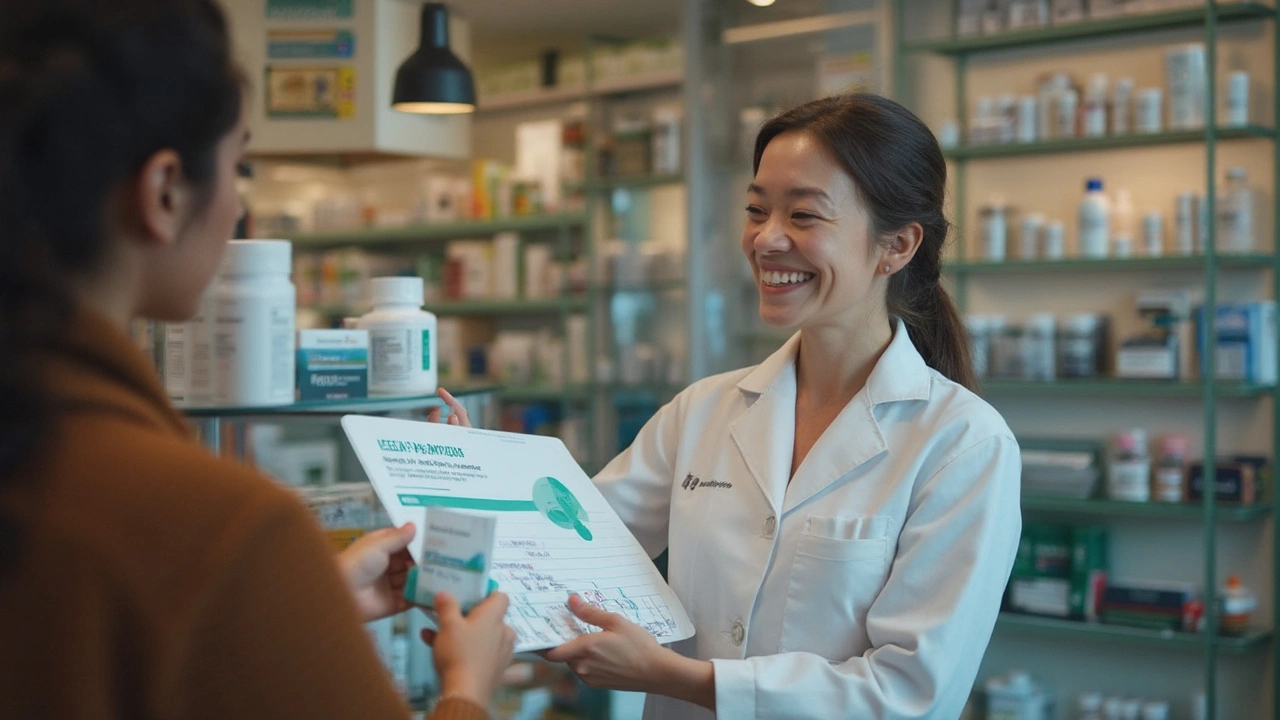Understanding Sevelamer Hydrochloride: Global Usage and Access

Sevelamer Hydrochloride might sound like a mouthful, but it's a lifesaver for folks with chronic kidney disease. This medication plays a crucial role in keeping phosphate levels in check without the risk of calcium overload, which is often a big concern when it comes to kidney health.
You might wonder why phosphate is such a big deal. When kidneys aren't working well, phosphate, which the body usually gets rid of, starts to pile up, and that can lead to a bunch of issues, especially with bones. Sevelamer Hydrochloride acts like a net, binding the phosphate up so it can't cause trouble.
But here's where things get tricky: not everyone around the world has the same access to this medication. Depending on where you are, getting your hands on Sevelamer Hydrochloride can be as easy as walking into your local pharmacy—or it can be a major quest.
Let's take a snapshot of its availability across the globe, how different countries manage its distribution, and what it means for patients who rely on it daily. We're also checking out what's on the horizon for this essential medication. Who knows, there might be new developments coming that could shake things up!
- What is Sevelamer Hydrochloride?
- Global Usage Patterns
- Access Challenges Around the World
- Future Prospects and Innovations
What is Sevelamer Hydrochloride?
Sevelamer Hydrochloride is a type of medication known as a phosphate binder. It’s often prescribed to folks dealing with chronic kidney disease, especially those undergoing dialysis. So, why the big deal about phosphate? Well, when kidneys can't properly filter waste from the blood, phosphate levels can skyrocket, which is not good news for bones and overall health.
Now, how does this drug actually work? It’s pretty clever. Sevelamer Hydrochloride binds phosphate from the food in your gut so it can't get absorbed into the bloodstream. Instead, it's safely eliminated from your body. What’s great about Sevelamer is that it doesn’t add calcium to the mix, which is a common problem with some other phosphate binders.
But when should this drug be taken? It’s usually taken with meals. This timing helps it capture phosphate right when it’s being digested. Easy, right? Just make sure you follow up with your healthcare provider regularly to monitor your progress.
Some Important Details
- Brand Names: While Sevelamer Hydrochloride is the active ingredient, it’s sold under brand names like Renagel and Renvela.
- Form: It generally comes in tablet form, sometimes as a powder.
- Side Effects: Like any medication, it can have side effects. The most common are digestive issues like nausea or constipation—definitely something to watch out for.
Lastly, it’s worth mentioning that this medication has been a game-changer for many patients, helping maintain their quality of life by managing complications from high phosphate levels. All in all, Sevelamer Hydrochloride is a key player in kidney health management, offering a tailored approach to a tricky problem.
Global Usage Patterns
When it comes to Sevelamer Hydrochloride, usage isn't one-size-fits-all across the globe. Different countries have their ways of incorporating this vital medication into healthcare systems. So, what's the pattern we can see?
Widespread Use in Developed Nations
In places like the U.S., Canada, and many parts of Europe, Sevelamer Hydrochloride is a go-to solution for managing phosphates in patients with chronic kidney disease (CKD). Healthcare providers routinely prescribe it, and most patients have no trouble getting it from their pharmacies.
Challenges in Developing Regions
But shift focus to regions like parts of Africa and Southeast Asia, and the picture changes. Here, access can be sporadic. Pharmacies might not stock it regularly, and patients often rely on donations or sporadic shipments, which can make treatment inconsistent. This inconsistency isn't just frustrating—it's a real medical risk when phosphate levels can't be managed effectively.
Variable Regulatory Approvals
The presence of Sevelamer Hydrochloride in a country's healthcare arsenal can also depend heavily on regulatory approvals and local healthcare policies. Some countries fast-track its approval due to its importance, while others may face bureaucratic bottlenecks.
Economic Factors
Cost can be another big determinant. Economies like Australia and Japan have insurance systems or government subsidies that often cover the cost, making access easy for most patients. Meanwhile, in countries without robust healthcare insurance systems, affordability can be a lingering barrier.
| Country | Accessibility | Cost Involvement |
|---|---|---|
| USA | High | Covered by Insurance |
| India | Moderate | Out-of-Pocket |
| South Africa | Low | Limited Coverage |
The importance of Sevelamer Hydrochloride is clear, but global usage patterns highlight serious inequalities that need addressing. As more countries recognize the impact of effective CKD management, the hope is for better policies and improved access worldwide.

Access Challenges Around the World
Getting Sevelamer Hydrochloride can be quite the task depending on where you live. In some countries, like the US and parts of Europe, it's fairly straightforward thanks to robust healthcare systems that have streamlined approval and distribution. But in other regions, especially in some developing countries, there's a different story.
Barriers in Developing Countries
In many developing countries, limited healthcare funding means that expensive drugs like Sevelamer Hydrochloride aren't always top of the list. Budget constraints force healthcare providers to prioritize basic medicines over more specialized treatments. As a result, patients may have to either go without or foot a hefty bill themselves.
Regulatory Hurdles
Another challenge is the varying pace of regulatory approval. While some countries fast-track essential medications, others have lengthy processes that delay availability. Different rules mean that even if Sevelamer Hydrochloride is available, navigating the paperwork can be cumbersome.
Pricing Issues
Ever wondered why drug prices vary so much? It's often due to local pricing negotiations and patent laws. In some regions, without government subsidies or insurance support, Sevelamer Hydrochloride can become prohibitively expensive for patients. This can lead to inconsistent access and even drive people to seek cheaper, unregulated alternatives.
Geographic Disparities
Even within individual countries, access can be uneven. Rural regions often face shortages due to supply chain issues or a lack of nearby pharmacies. It's not uncommon for patients in these areas to travel long distances for a prescription refill.
| Region | Availability | Challenges |
|---|---|---|
| North America | High | Cost |
| Europe | High | Regulation delays |
| Sub-Saharan Africa | Low | Funding and distribution |
| Asia | Moderate | Pricing and logistics |
Addressing these challenges isn't easy, but it's crucial for ensuring that everyone who needs Sevelamer Hydrochloride can access it without jumping through hoops. It's a complex puzzle involving healthcare policies, international cooperation, and innovative solutions.
Future Prospects and Innovations
When it comes to the future of Sevelamer Hydrochloride, there's a lot on the horizon. Researchers and pharma companies are consistently trying to make this medication more effective and accessible for those who need it most. Let's peek into what's buzzing in the world of kidney health and phosphate binding.
Advancements in Formulation
One of the main areas of innovation is improving how the medication is delivered. Current research is focused on making Sevelamer Hydrochloride formulations that are easier to swallow and require fewer doses a day. Imagine not having to pop pills left and right!
Global Accessibility
While access challenges exist today in many regions, efforts are underway to ensure that the medication doesn't just remain a privilege for first-world countries. Some organizations are even looking at producing generic versions that maintain the same effectiveness as the original. Let's hope these efforts level the playing field worldwide, making kidney health management accessible to all.
Integration with Other Therapies
The future could also see Sevelamer Hydrochloride being used in combination with other treatments for better overall results. Think of it as having a complete toolset rather than just one tool. These combinations might provide greater flexibility for patients and doctors in managing chronic conditions.
Case Studies and Research
As research continues, data from various studies are helping inform best practices and treatment guidelines globally.
| Study Year | Finding |
|---|---|
| 2024 | Improved patient outcomes with integrated treatment regimens |
| 2023 | 30% cost reduction with generic versions |
All said and done, as more is learned and done in the realm of Sevelamer Hydrochloride, patients worldwide look poised to benefit from advancements in both treatment and access.

Wow, reading about sevelamer really opened my eyes about how uneven drug access is worldwide.
It’s crazy that a pill that can save lives is easy to grab in the US but feels like a treasure hunt in parts of India.
Honestly, I’ve seen patients travel hours just to get a refill, and that stress adds to their already heavy health burden.
When the pharmacies don’t stock it, families end up borrowing money or relying on NGOs, which isn’t sustainable.
Government subsidies can make a huge difference, yet many low‑income countries lack the budget for such programs.
Also, the regulatory maze slows down approvals, meaning even if the drug is manufactured locally, paperwork can keep it from reaching clinics.
But we need more data to ensure those generics are just as effective and safe for patients.
Education of healthcare workers about proper dosing is another piece of the puzzle that often gets overlooked.
Patients sometimes stop the medication because of side effects like constipation, so diet counseling should go hand‑in‑hand with prescriptions.
International cooperation could help create a shared procurement pool, lowering prices through bulk buying.
Telemedicine might also play a role, allowing doctors to monitor phosphate levels remotely and adjust therapy without frequent trips.
Ultimately, equitable access isn’t just a medical issue; it’s a social justice matter that ties into poverty and education.
I hope future policies will treat sevelamer as an essential medicine rather than a luxury.
Let’s keep the conversation going and push for real change, because every kidney patient deserves the chance to live without constant fear of phosphate spikes.
Thanks for shedding light on this, it’s a conversation we all need to have.
Ah, the noble quest for phosphate control-how very avant‑garde of modern medicine, truly the pinnacle of human achievement. One might argue that sevelamer is the Michelangelo of binders, sculpting away excess phosphate with the finesse of a Renaissance master. Yet, alas, the mere mortals in the developing world are relegated to watching this masterpiece from afar, pondering if they’ll ever taste such refined chemistry. It's almost poetic how bureaucracy and price tags conspire to keep such a marvel out of reach, a tragic drama worthy of Shakespeare himself. One can only sigh at the irony: we have rockets landing on Mars while a kidney patient in a rural village struggles for a tablet.
But fear not, dear reader, for the future promises generic alchemists to democratize the miracle, and perhaps one day the world will grant sevelamer the status it deserves-nothing less than a global right, not a privileged commodity.
Sevelamer's cost remains prohibitive in many low‑income regions.
Totally feel you, Stephen 😄-it does sound like a blockbuster saga, but the reality for patients is far less glamorous. Still, love the optimism about generics, fingers crossed! 🙌
Enough talk-go fix the supply chain now! Patients are dying because of red tape and empty shelves.
it hurts us all when meds dont arrive on time we all suffer